Art of Evidence
Those that have recently passed in and out of Fairmont State University’s Wallman Hall may have noticed a “dead body” laying on the 4th floor Gallery. The University’s forensic science department and the school of fine arts became a team to present an “Art of Evidence” studio exhibit.
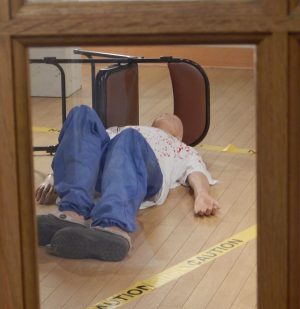
One studio art major, Sable Herrod commented on the new team by stating, “The collaboration between the forensics department and ours was an enlightening experience! I’d never collaborated on a piece with anyone outside of the arts before, but we found a lot of common ground. I would love to do more projects like this!”
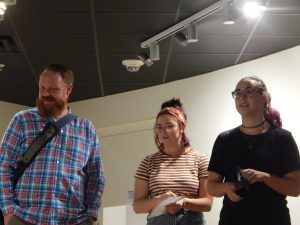
The new “Art of Evidence” team provided a brief description of the exhibit that read: “An important concept when dealing with crimes is Locard’s Exchange principle, which is the fact that everywhere you go you leave something behind and you take something from the places you’ve been. The things that are taken or left from a crime scene are Items of evidence. Each piece of evidence has unique characteristics that can be taken advantage of to look for a “common origin” between crime scene evidence and samples from known individuals.
We hope this collaborative display between Art and Forensic Science engages you in the features of evidence analysis and immerses you in the intricacies of processing evidence such as fiber, bone, blood, fingerprints, and DNA. May you leave with something more than when you arrived and leave traces of you behind!”
This exhibit features five key roles in the “Art of Evidence”. The key roles are a closer view of fibers and hair, casting and identification of bones, colors and spatter patterns of blood, unique life of an individual’s fingerprint, and the art of DNA.
Jackie Kovach stated, “This is totally different from other stuff I have done because the time length was shorter than what I was use to. Working with products in different ways was also fun! In this process I could get out of my comfort zone successfully.”
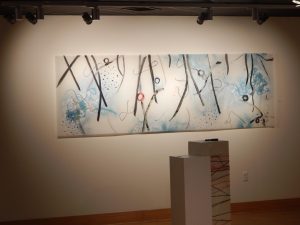
Fibers are trace evidence of physical contact from suspect to victim that are left at a crime scene. Although sometimes microscopic, an analysis of fibers can provide identification and comparisons. For a fabric to be identified as originating from the victim or suspect, the fiber must be consistent in composition and color to the clothing in the individual’s ownership. This show provides different fibers to practice examining under a magnifying glass. The art is a representation of what these fibers may look like under a microscope.
Forensic anthropologists can estimate the age and gender of victims using various bone markers. For example, a female skeleton is often smaller than that of a healthy male skeleton, but the female skeleton has a broader pelvis. Another helpful bone marker is teeth. If dental records are available, the teeth can serve as identification from the victim.

In addition to bone markers, blood spatter is analyzed to determine the way in which a murder occurred. The task of analyzing blood spatter requires a comprehensive understanding of human anatomy, blood and spatter velocity patterns. By analyzing blood spatter you can determine approximately what happened and how it happened. The spatter indicates the weapon used, how many times the victim was hit, the angles gunshots were fired from, where the suspect was in relation to the victim, and a frame of time in which the crime took place. Though not with blood, the art classes had fun with practicing paint spatter patterns.
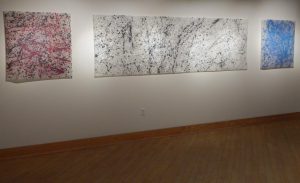
Another form of significant evidence is the fingerprint. The fingerprint is significant because it is unique to the individual. When fingerprints are examined, the analyst compares distinct points of individuality in the collected prints to the suspect(s) prints. The evaluation is based on the analyst’s interpretation of the evidence and the number of points in agreement.
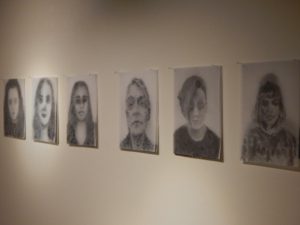
Over the years, DNA has become a popular tool for the prosecution of suspects. Due to limited resources, many crime laboratories are only able to perform DNA testing on evidence collected from violent crimes. The samples collected are sent to a laboratory to be analyzed and prepared for comparison to the Combined DNA Index System (CODIS). The Combined DNA Index System is the FBI’s program of support for criminal justice DNA databases. By utilizing DNA as a tool to prosecute criminals, forensic scientists are aiming to reduce the societal and economic impact of crimes.
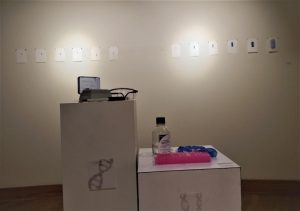
Caroline Thompson felt that “The Art Department did a wonderful job at capturing the essence of what crime scene evidence is like in the mind of a forensic scientist. My favorite piece was the fibers painting, because it was very realistic to what fibers are like under a microscope.”



